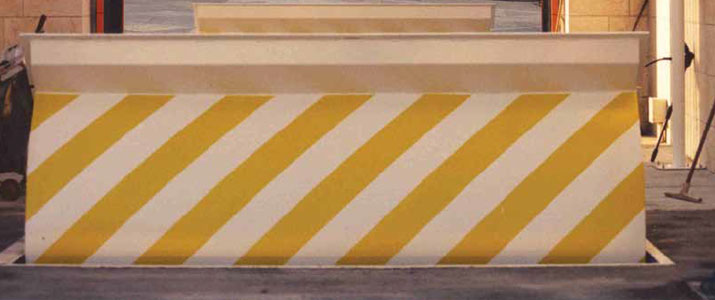
Stopping Truck Bombers
Crash-rated barriers have long history with U.S. Department of State
 Visit any U.S. Embassy throughout the world, including
major embassies, such as Beijing, and smaller ones in Estonia,
Indonesia, Papua New Guinea, Ivory Coast, Guatemala,
Nepal, Lithuania and Madagascar, even consulates
in Florence, Italy, Sarajevo, Vienna and cities in Germany, Greece,
Macedonia and Saudi Arabia, and you will find them protected from
vehicle assaults and some even from bio-attacks.
Visit any U.S. Embassy throughout the world, including
major embassies, such as Beijing, and smaller ones in Estonia,
Indonesia, Papua New Guinea, Ivory Coast, Guatemala,
Nepal, Lithuania and Madagascar, even consulates
in Florence, Italy, Sarajevo, Vienna and cities in Germany, Greece,
Macedonia and Saudi Arabia, and you will find them protected from
vehicle assaults and some even from bio-attacks.
The following provides examples in which highly-secure, crashrated,
vehicle barricade systems and bollards have saved lives as well
as buildings and property from the destruction of attacks.
U.S. Embassy in Dar Es Salaam, Tanzania and Nairobi, Kenya.
In Tanzania, 1998, a crash-rated, moveable barricade prevented an
attacker’s vehicle from entering the rear compound of the building,
thus, reducing the loss of lives and damage to the facility. Unfortunately,
no barricades were used at the embassy in Kenya when it was
bombed the same day.
By September of that year, however, 14 barriers, including moving-
wedge barricades and crash-rated bollards, were shipped to these
two embassies.
Harry S. Truman Building. At the dedication of the U.S. Department
of State headquarters, held in Washington, D.C. on Sept. 22,
2000, bollards provided a first line of defense by securing the diplomatic
and congressional drive entrances.
These custom, stainless-steel bollards feature lights to improve
visibility at night. They are designed to destroy the front suspension
system, steering linkage, engine crank case and portions of the drive
train of any 15,000-pound, non-armored or non-tracked vehicle hitting
them at 62 mph. The system will also stop a 30,000-pound vehicle
traveling at 44 mph.
These bollards are raised and lowered into the guard position by
a remote controlled, precision, hydraulic power unit or a precision
pneumatic power system. Under emergency conditions, the bollards
can be raised in as little as a single second. And, with the exception of
minor, non-structural damage, such as scratches, they are fully operational
after taking a 65 mph hit from a five-ton vehicle.
Yemeni port of Aden. Just one month after the dedication of the
U.S. Department of State headquarters and within hours after the terrorist
bombing of the USS Cole at the Port of Aden, on Oct. 12, 2000,
barriers were airlifted to Yemen for deployment there and at nearby,
prospective targets.
U.S. Embassy in Yemen. At the most recent attack in September
2008, barricades were up protecting the entrance and keeping bombers
outside the compound. These barriers tested at K54, which will
stop a 65,000-pound truck, traveling at 70 mph. That’s 5.4 million
foot-pounds of energy!
At the entrance to the embassy, the barrier creates a sally-port
with a crash-resistant gate to tightly control traffic into the embassy. It
is lowered to let in a car, while the gate in front of the car stays closed.
The barrier in back then raises, and the car is sandwiched between it
and the gate. Once searched and approved, the gate opens, and the car
is allowed to enter the embassy.
U.S. Embassy in Amman, Jordan. Situated in the middle of one
of the most volatile areas of the world, this embassy relies on a crashrated
barrier to protect its facilities from the threat of terrorism. The
barrier protects the compound from charging vehicles and creates a
sally-port, similar to that at the Yemeni embassy, which tightly controls
traffic into the embassy.
U.S. Consulate in Peshawar, Pakistan. In 2010, barricades helped
retain attackers by preventing a bomber’s vehicle from crashing past
pedestrian gates, forcing the attackers to detonate a truck bomb far
from the building. The barricades successfully stopped the attack vehicle
away from the building and diminished the high-pressure shock
wave of a bomb blast, saving lives and the property.
With more than 170 U.S. Embassies and Consulates in 130-plus
countries, it is imperative to incorporate premier, perimeter protection
that meets or exceeds U.S. Department of State and Department
of Defense certification standards, while providing high-security in
order to counter terrorism.
This article originally appeared in the November 2013 issue of Security Today.
About the Author
Greg Hamm is the vice president of sales and marketing at Delta Scientific.